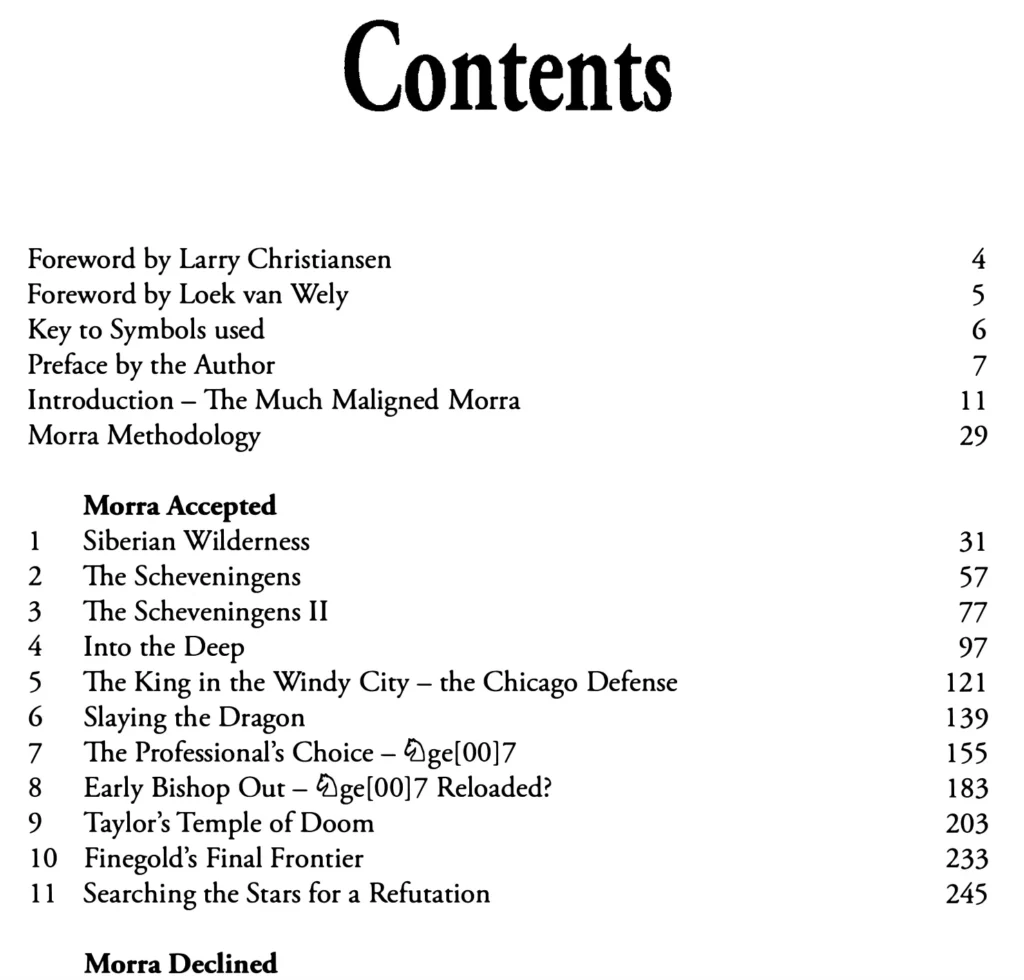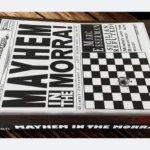If you’ve ever wanted to play the Sicilian against Black rather than survive it, Marc Esserman’s Mayhem in the Morra is the cult-classic, attack-heavy, engine-tested monster that refuses to die.
First published in 2014, this 360-page tome is still the Smith–Morra Gambit Bible, endorsed by grandmasters, feared by Sicilian loyalists, and adored by chess romantics who still believe in open lines, rapid development, and checkmate.
But is it actually practical? Can a gambit this wild survive modern engines? And is this book truly as good as its legendary reputation?
Let’s break it down.
What This Book Wants to Teach You
At its core, Mayhem in the Morra does two things at once:
- Provides a full, fighting repertoire for White against every major Sicilian line.
Whether Black accepts or declines the gambit, Esserman has prepared novelties, traps, sidelines, model games, and complete attacking plans. - Converts you into a Morra believer.
Seriously—Esserman is not neutral. He’s evangelical about the gambit. He wants you to feel the beauty, not just memorize lines.
This is not a light opening survey. It is a philosophy, a manifesto, and a deeply personal project by someone who has lived, breathed, and weaponized the gambit for decades.
You’re not just learning the Smith–Morra.
You’re joining a movement.
A Gambit With a Reputation: What the Forewords Reveal
Most opening books have a polite foreword where a GM says something like, “Good job, this book is useful.” Not here.
Mayhem in the Morra opens with two forewords, and both read like warnings.
Larry Christiansen: “It’s not business, it’s strictly personal.”
Christiansen explains how Esserman turned the Morra from a “quaint pet” into a snarling pitbull. He talks about skeptics being converted, “refutations” being refuted, and Black players becoming “meek decliners.”
He even admits he used Esserman’s analysis to prepare for the US Championship.
For a line many believe to be dubious… that says a lot.
Loek van Wely: “Is he serious?”
Van Wely describes their 2011 game, where Esserman crushed him with the Morra and forced him—an elite top-10 GM—to take the gambit seriously for the first time.
Again: this is not normal for an opening book.
It feels like you’re being inducted into a secret society.
The Structure of the Book
Just like the Woodpecker Method book is shaped by its training philosophy, Mayhem in the Morra is shaped by the dual nature of the gambit:
1. Morra Accepted (Chapters 1–11)
This is the meat of the book—Esserman’s life work.
You get:
- The Siberian traps
- The Chicago Defense
- The Scheveningen setups
- The Dragon setups
- Deep lines like “Into the Deep”
- Esserman’s refutation attempts
- His novelties
- Massive attacking motifs
- And a ridiculous amount of model games
This section alone is worth the price of the book.
2. Morra Declined (Chapters 12–14)
This is where Esserman shows why early …d3, …Nf6, and other sidelines don’t solve Black’s problems. The highlight is the chapter “Crushing 3…d3 with the Morra-Maroczy: squeeze, squeeze, destroy!”
Even if Black refuses your gambit, Esserman argues you still get a comfortable initiative.
3. Appendices & Indexes
Over 40+ pages of games, notes, citations, and variations.
It’s obsessive, and in a good way.

What It’s Like to Read the Book
The tone is dramatic, passionate, and occasionally hilarious. Esserman writes like someone who:
- loves the gambit,
- loves the history of Romantic chess,
- and really wants to kill the Sicilian Defense.
The preface reads like a coming-of-age novel—about a 16-year-old Esserman using the Morra against a co-author of the Finegold Defense… and almost beating him.
Then beating FM Chow with a knight on e6.
Then beating Nakamura.
You’re reading the story of a teenager discovering a dangerous weapon and then using it to beat masters who claim it’s unsound.
It’s inspiring.
It’s personal.
And it makes you want to play 1.e4 c5 2.d4 right now.
How the Book Actually Helps You Improve
This is not just an opening book. It builds real skills:
1. You learn how to attack like a Romantic—but with engine guidance.
Morphy spirit, Stockfish precision.
2. You train your intuition for open positions.
Central control, initiative, development—Esserman drills these ideas hard.
3. You get practical weapons that work even at high levels.
Whether the gambit is fully “sound” doesn’t matter. Esserman arms you with lines that are:
- aggressive
- poisonous
- well-tested
- psychologically unpleasant for Black
4. You get a complete repertoire, not a patchwork of tricks.
Every Black reply is covered in depth.
5. You gain an identity as a player.
After reading this book, you’re not “playing the Morra.”
You’re living it.
What Players Say (Summarized)
Across online platforms, comments about this book are remarkably consistent:
“This book made me fall in love with chess again.”
People say the Morra made chess fun, creative, and dynamic again.
“I don’t even play the Morra, but the book is incredible.”
Several reviewers describe it as one of the best-written chess books ever.
“It’s basically a Morra cult manual. I love it.”
Humor, passion, and lots of forced Sicilian players complaining.
“The lines are still mostly valid in 2025.”
Even with engine evolution, Esserman’s ideas hold up better than expected.
“This book made me switch to 1.e4 just so I can play this gambit.”
Possibly the highest praise an opening book can get.
Who This Book Is For
Buy this book if you…
- love open, tactical, forcing chess
- want an anti-Sicilian weapon that punishes unprepared opponents
- enjoy personal, passionate, story-driven chess writing
- want to surprise even strong players
- want a fully worked-out attacking repertoire
Avoid this book if you…
- prefer quiet positional maneuvering
- want perfect engine-evaluated objectivity
- dislike speculative pawn sacrifices
- refuse to enter sharp positions
If you want the Petroff… this isn’t your vibe.
But if you want to drag Black into chaos?
Welcome home.
Is the Morra Actually Sound?
This is the million-dollar question.
Esserman’s stance:
Yes. 100%. Fight me.
Modern engines’ stance:
It’s complicated, but playable.
Practical players’ stance:
It wins games. A lot of games.
Here’s the truth:
If your goal is to reach dynamic, initiative-driven positions where you’re better prepared than your opponent, the Morra is absolutely good enough, even at titled level.
And this book gives you everything you need.
Final Verdict: 9.5/10 – A Modern Classic
Mayhem in the Morra is more than an opening manual. It’s a piece of chess culture—romantic, rebellious, and beautifully written. Esserman takes a maligned gambit and turns it into a fully armed, strategically coherent system that continues to score practical wins.
It’s not neutral.
It’s not objective.
It’s not modest.
It’s passionate, wild, and deeply researched.
Just like the gambit itself.
If you want to inject adrenaline into your 1.e4 repertoire, this is the best Smith–Morra resource ever written.
Support the Site
👉 Ready to bring chaos to the Sicilian? Grab Mayhem in the Morra on Amazon here (affiliate link) or get the Forward Chess ebook. Buying through these links supports this site at no extra cost to you.

I’m Xuan Binh, the founder of Attacking Chess, and the Deputy Head of Communications at the Vietnam Chess Federation (VCF). My chess.com and lichess rating is above 2300. Send me a challenge or message via Lichess. Follow me on Twitter (X) or Facebook.






